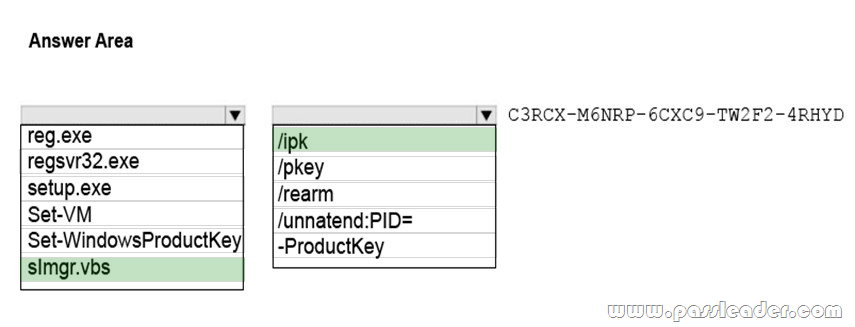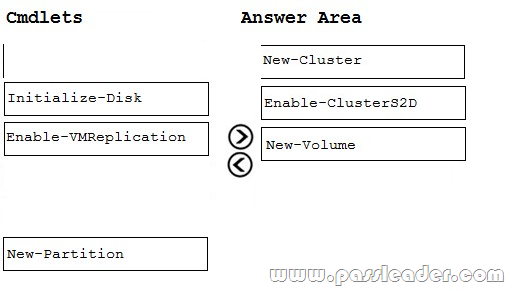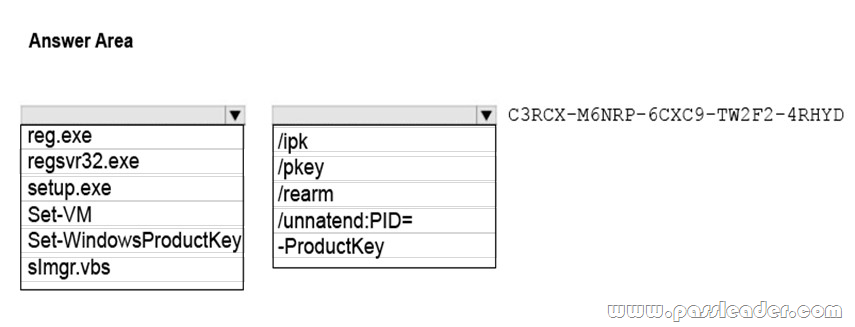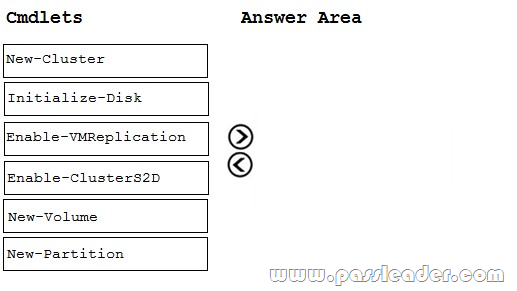Valid 70-740 Dumps shared by PassLeader for Helping Passing 70-740 Exam! PassLeader now offer the newest 70-740 VCE dumps and 70-740 PDF dumps, the PassLeader 70-740 exam questions have been updated and ANSWERS have been corrected, get the newest PassLeader 70-740 dumps with VCE and PDF here: https://www.passleader.com/70-740.html (277 Q&As Dumps –> 308 Q&As Dumps –> 355 Q&As Dumps)
BTW, DOWNLOAD part of PassLeader 70-740 dumps from Cloud Storage: https://drive.google.com/open?id=0B-ob6L_QjGLpN1dmQkk4T3ZVVlU
NEW QUESTION 263
You have four servers named Server1, Server2, Server3, and Server4 that run Windows Server 2016. Server1 and Server2 have the Hyper-V server role installed. Server1 hosts a virtual machine named VM1. Server2 hosts a virtual machine named VM2. Server3 hosts the disks and the configurations of both virtual machines on an SMB share named VMShare. You use Server4 to manage Hyper-V operations on Server1 and Server2. From Server4, you attempt to perform a live migration of VM1 and VM2, but you receive the following error message: “No credentials are available in the security package”. You need to ensure that you can perform the live migration of VM1 and VM2 between Server1 and Server2 while signed in to Server4. What should you do?
A. From Active Directory Users and Computers, modify the properties of Server4.
Configure the delegation settings to trust the computer for delegation of cifs.
B. From Windows PowerShell on Server3, run the remove-SMBMultiChannelConstraint cmdlet, and then assign Server4 Full Control permissions to VMShare.
C. From Active Directory Users and Computers, modify the properties of Server1 and Server2.
Configure the Delegation settings to trust the computers for delegation of the Microsoft Virtual System Migration Service.
D. From Active Directory Users and Computers, modify the properties of your user account.
Modify the Account is sensitive and cannot be delegated setting.
Answer: C
Explanation:
https://docs.microsoft.com/en-us/windows-server/virtualization/hyper-v/deploy/set-up-hosts-for-live-migration-without-failover-clustering
NEW QUESTION 264
You have a server that runs Windows Server 2016 Standard. You create a new three-way mirror storage space. You format the storage space by using ReFS. Which two features can you use on the new storage space? (Each correct answer presents a complete solution. Choose two.)
A. file and folder permissions
B. disk quotas
C. Encrypting File System (EFS)
D. long file names
E. Data Deduplication
Answer: AE
NEW QUESTION 265
You have a server named Server1 that runs Windows Server 2016. Server1 has the Hyper-V server role and Docker installed. You pull the Microsoft/iis Docker image to Server1. You need to view the available space in the Microsoft/iis Docker image.
Solution: You run the command docker run isolation hyperv -d microsoft/iis. You open Disk Management on Server1.
Does this meet the goal?
A. Yes
B. No
Answer: B
NEW QUESTION 266
You have a Hyper-V host named Server1 that runs Windows Server 2016. Server1 hosts a virtual machine named VM1 that runs Windows Server 2016. On VM1, Dynamic Memory is disabled, MAC spoofing is enabled for the virtual network adapter, and checkpoints are disabled. You need to ensure that you can install the Hyper-V server role on VM1. What should you do?
A. Shut down VM1, enable Dynamic Memory on VM1, and then start VM1.
B. Shut down VM1, run the Set-VMProcessor cmdlet, and then start VM1.
C. Disable Hyper-V integration services for VM1, and then restart VM1.
D. Configure VM1 to use standard checkpoints.
Answer: B
Explanation:
https://docs.microsoft.com/en-us/virtualization/hyper-v-on-windows/user-guide/nested-virtualization
NEW QUESTION 267
You have a server named Server1 that runs Windows Server 2016 and has the File and Storage Services server role installed. Server1 has an ReFS-formatted volume named Volume1 that is 512 GB. Volume1 is mounted as C:\App1 \temp. You need to ensure that you can enable deduplication of Volume1. What should you do?
A. Format Volume1.
B. Unmount Volume1.
C. Install a Windows feature.
D. Initialize the physical disk that contains Volume1.
Answer: C
Explanation:
https://docs.microsoft.com/en-us/windows-server/storage/data-deduplication/install-enable
https://docs.microsoft.com/en-us/windows-server/storage/refs/refs-overview
NEW QUESTION 268
You have two Hyper-V hosts named Server1 and Server2 that run Windows Server 2012 R2. The servers are nodes in a failover cluster named Cluster1. You perform a rolling upgrade of the cluster nodes to Windows Server 2016. You need to ensure that you can implement the Virtual Machine Load Balancing feature. Which cmdlet should you use?
A. Update-ClusterNetWorkNameResource
B. Set-ClusterGroupSet
C. Set-CauClusterRole
D. Update-ClusterFunctionalLevel
Answer: D
Explanation:
https://docs.microsoft.com/en-us/windows-server/failover-clustering/cluster-operating-system-rolling-upgrade#cluster-os-rolling-upgrade-process
NEW QUESTION 269
You have a Windows Server 2016 failover cluster named Cluster1 that contains four nodes named Server1, Server2, Server3, and Server4. You need to configure Cluster 1 to use directly attached storage to store several virtual machines. You run the Enable-ClusterStorageSpacesDirect cmdlet on Server1. What should you do next?
A. Run the Enable-ClusterStorageSpacesDirect cmdlet on the other three nodes.
B. Create volumes.
C. Create a storage pool.
D. Run the Add-ClusterResource cmdlet on all of the nodes.
Answer: B
Explanation:
https://medium.com/beyond-the-helpdesk/setting-up-and-configuring-storage-spaces-direct-in-windows-server-2016-4d2be85a8f7d
NEW QUESTION 270
You have a Hyper-V server named Server1 that runs Windows Server 2012 R2. Server1 hosts a virtual machine named VM1 that runs Windows Server 2016. VM1 connects to an external virtual switch named Switch1. You can ping VM1 from Server1. You upgrade Server1 to Windows Server 2016. You need to ensure that you can connect to VM1 by using PowerShell Direct. What should you do?
A. Configure the firewall rules on Server1.
B. Enable the Hyper-V extensible switch extensions on Server1.
C. Upgrade the configuration version of VM1.
D. Configure the firewall rules on VM1.
Answer: C
Explanation:
https://docs.microsoft.com/en-us/windows-server/virtualization/hyper-v/deploy/upgrade-virtual-machine-version-in-hyper-v-on-windows-or-windows-server
NEW QUESTION 271
You have a server named Server1 that runs Windows Server 2016. Windows Defender is enabled on Server1. Server1 runs an application named App1 that stores various types of files in Microsoft OneDrive for Business, MicrosoftOneDrive, and Microsoft SharePoint Online. App1 also interacts with several local services. You need to prevent Windows Defender from scanning any files opened by App1. What should you do on Server1?
A. From the Windows Defender settings, configure a file exclusion.
B. Run the New-CiPolicy cmdlet.
C. Modify the real-time protection settings in Windows Defender.
D. From the Windows Defender settings, configure a process exclusion.
Answer: A
Explanation:
https://www.windowscentral.com/how-exclude-files-and-folders-windows-defender-antivirus-scans
NEW QUESTION 272
Hotspot
You have a Hyper-V host named Server1 that runs Windows Server 2016 datacenter. Server1 is activated. On Server1, you deploy a virtual machine named VM1 that has a Server Core installation of Windows Server 2016 Standard. You need to activate VM1 by using Automatic Virtual Machine Activation (AVMA). Which command should you run? (To answer, select the appropriate options in the answer area.)
Answer:

Explanation:
https://blogs.technet.microsoft.com/askcore/2013/11/13/activating-virtual-machines-via-automatic-virtual-machine-activation-in-windows-server-2012-r2/
NEW QUESTION 273
Drag and Drop
Your network contains an Active Directory domain named adatim.com. The domain contains four member servers that run Windows Server 2016. On each server, you locally attach three disks and install the Failover Clustering feature. You need to create a volume that uses all the disks. The volume must be highly available. Which three cmdlets should you run in sequence? (To answer, move the appropriate cmdlets from the list of cmdlets to the answer area and arrange them in the correct order.)
Answer:

Explanation:
https://argonsys.com/learn-microsoft-cloud/articles/configuring-storage-spaces-direct-step-by-step-part-1-core-cluster/
NEW QUESTION 274
……
Get the newest PassLeader 70-740 VCE dumps here: https://www.passleader.com/70-740.html (277 Q&As Dumps –> 308 Q&As Dumps –> 355 Q&As Dumps)
And, DOWNLOAD the newest PassLeader 70-740 PDF dumps from Cloud Storage for free: https://drive.google.com/open?id=0B-ob6L_QjGLpN1dmQkk4T3ZVVlU

